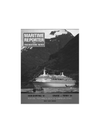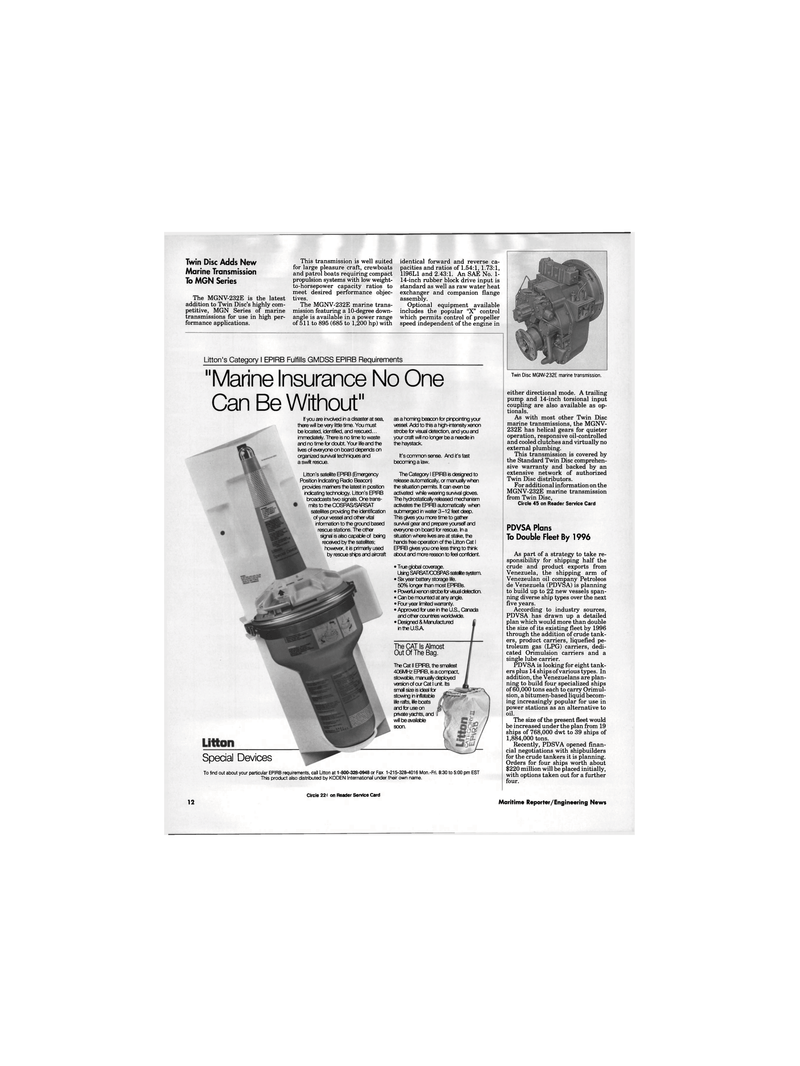
Page 10: of Maritime Reporter Magazine (May 1991)
Read this page in Pdf, Flash or Html5 edition of May 1991 Maritime Reporter Magazine
Twin Disc Adds New
Marine Transmission
To MGN Series
The MGNV-232E is the latest addition to Twin Disc's highly com- petitive, MGN Series of marine transmissions for use in high per- formance applications.
This transmission is well suited for large pleasure craft, crewboats and patrol boats requiring compact propulsion systems with low weight- to-horsepower capacity ratios to meet desired performance objec- tives.
The MGNV-232E marine trans- mission featuring a 10-degree down- angle is available in a power range of 511 to 895 (685 to 1,200 hp) with identical forward and reverse ca- pacities and ratios of 1.54:1, 1.73:1, 1196L1 and 2.43:1. An SAE No. 1- 14-inch rubber block drive input is standard as well as raw water heat exchanger and companion flange assembly.
Optional equipment available includes the popular "X" control which permits control of propeller speed independent of the engine in
Twin Disc MGNV-232E marine transmission. either directional mode. A trailing pump and 14-inch torsional input coupling are also available as op- tionals.
As with most other Twin Disc marine transmissions, the MGNV- 232E has helical gears for quieter operation, responsive oil-controlled and cooled clutches and virtually no external plumbing.
This transmission is covered by the Standard Twin Disc comprehen- sive warranty and backed by an extensive network of authorized
Twin Disc distributors.
For additional information on the
MGNV-232E marine transmission from Twin Disc,
Circle 45 on Reader Service Card
PDVSA Plans
To Double Fleet By 1996
As part of a strategy to take re- sponsibility for shipping half the crude and product exports from
Venezuela, the shipping arm of
Venezeulan oil company Petroleos de Venezuela (PDVSA) is planning to build up to 22 new vessels span- ning diverse ship types over the next five years.
According to industry sources,
PDVSA has drawn up a detailed plan which would more than double the size of its existing fleet by 1996 through the addition of crude tank- ers, product carriers, liquefied pe- troleum gas (LPG) carriers, dedi- cated Orimulsion carriers and a single lube carrier.
PDVSA is looking for eight tank- ers plus 14 ships of various types. In addition, the Venezuelans are plan- ning to build four specialized ships of 60,000 tons each to carry Orimul- sion, a bitumen-based liquid becom- ing increasingly popular for use in power stations as an alternative to oil.
The size of the present fleet would be increased under the plan from 19 ships of 768,000 dwt to 39 ships of 1,884,000 tons.
Recently, PDSVA opened finan- cial negotiations with shipbuilders for the crude tankers it is planning.
Orders for four ships worth about $220 million will be placed initially, with options taken out for a further four.
Litton's Category I EPIRB Fulfills GMDSS EPIRB Requirements "Marine Insurance No One
Can Be Without"
To find out about your particular EPIRB requirements, call Litton at 1-800-328-0948 or Fax 1-215-328-4016 Mon.-Fri. 8:30 to 5:00 pm EST
This product also distributed by KODEN International under their own name.
Circle 252 on Reader Service Card 12 Maritime Reporter/Engineering News • True global coverage.
Using SARSAT/COSPAS satellite system. • Six year battery storage life. 50% longer than most EPIRBs. • FtwerU xenon strobe for visual detection. • Can be mounted at any angle. • Four year limited warranty. • Approved for use in the U.S., Canada and other countries worldwide. • Designed & Manufactured in the U.SA
The CAT Is Almost
Out Of The Bag. as a homing beacon for pinpointing your vessel. Add to this a high-intensity xenon strobe fa visual detection, and you and your craft will no longer be a needle in the haystack.
It's common sense. And it's fast becoming a law.
The Category I EPIRB is designed to release automatically, or manually when the situation permits. It can even be activated while wearing survival gloves.
The hydrostatically released mechanism activates the EPIRB automatically when submerged in water 3-12 feet deep.
This gives you more time to gather survival gear and prepare yourself and everyone on board for rescue. In a situation where lives are at stake, the hands free operation of the Litton Cat I
EPIRB gives you one less thing to think about and more reason to feel confident.
If you are involved in a disaster at sea, there will be very little time. You must be located, identified, and rescued... immediately. There is no time to waste and no time for doubt. Your life and the lives of everyone on board depends on organized survival techniques and a swift rescue.
Litton's satellite EPIRB (Emergency
Position Indicating Radio Beacon) provides mariners the latest in position indicating technology. Litton's EPIRB broadcasts two signals. One trans- mits to the COSPAS/SARSAT satellites providing the identification of your vessel and other vital information to the ground based rescue stations. The other signal is also capable of being received by the satellites; however, it is primarily used by rescue ships and aircraft
Special Devices
The Cat II EPIRB, the smallest 406MHz EPIRB, is a compact, stowable, manually deployed version of our Cat I unit. Its small size is ideal for stowing in inflatable life rafts, life boats and for use on private yachts, and will be available soon.

 9
9

 11
11
